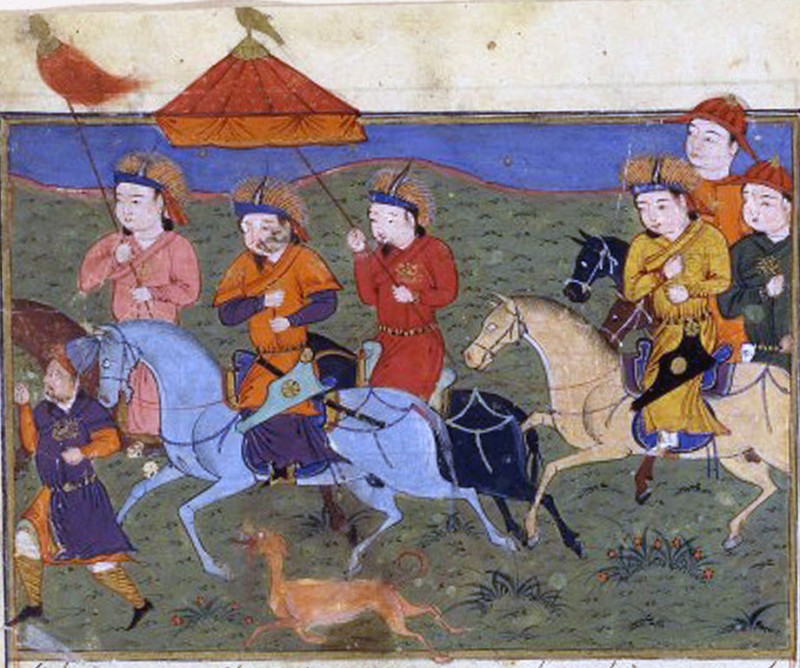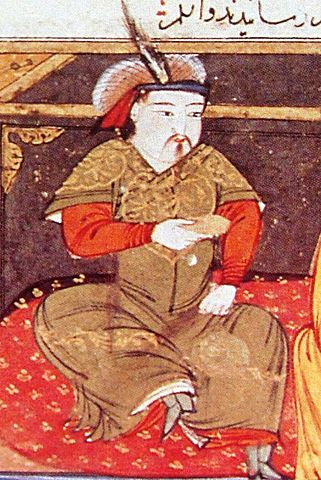Our Article about Ebesh Hatun of Iran, a Ruling Woman in Islam on MintPress
Great Women In Islamic History: Ebesh Hatun Of Iran
Follow @promosaik_ @promosaik_

painting of Hulagu Khan by Persian historian Rashid al-Din. Hulagu Khan
rides on horseback with
his mounted army, accompanied by a hunting dog
and footmen. Like many leaders of the era,
Ebesh Hatun held power by
swearing allegiance to a Mongol ruler. (Wikimedia /
Bibliothèque
nationale de France).
Other selections from this series: Introduction: A Forgotten Study Of Female Political Power In Muslim History, Türkan Hatun of Iran, and Padishah Hatun of Iran.
Ebesh Hatun Of The Fars Princedom Of Salgur
Ebesh Hatun (also known as Abish Hatun) was a Turkish woman renowned
as the recognized sovereign of the State of Salgur, in the Fars province
in the second half of the 13th century (1283-1287).
A brief history of Salgur
In this chapter of her book, historian Bahriye Üçok briefly
introduces the founding history of this state to make us understand
under which condition a woman was able to come to power.

illustration of Ebesh Hatun in a hat and flowing, button-up shirt with
long flowing dark hair. (Illustration from Dr. Bahriye Üçok’s “Female
Sovereigns in Islamic States.”)
The name of the princedom originates from Salgur, who was the leader
of one of the Turcoman communities and then became chamberlain to Tuqrul
of the Iraq Seljuks. One of Salgur’s grandsons, Sungur bin Mevdut, rose
against the Seljuks in 1147-8 following the murder of an emir related
to him, and proclaimed independence in the province of Fars.
So Salgur became independent and Shiraz its capital. However, this
independence was not to last for long. The Salgurs started to pay taxes
at first to the Seljuks of Iraq, and later, in the time of Atabey I Sa’d
to the Harezmshah.
The sixth ruler, Ebubekir, feeling himself at risk by the Mongols,
announced his allegiance to Hakan Ögedey and Ilhan Hulagu in 1256 by
paying taxes to them. Under Ebubekir, the Salgurs prospered and expanded
until his death. His son Sa’d II followed him.
After his death, the people of Shiraz put his young son Muhammed on the throne. Türkan Hatun,
his mother, acted as regent. This is one of various examples we find in
Üçok’s book: indeed, many female rulers got the chance to rule because
the male successors were too young or not competent enough. To protect
herself from the Mongols, Türkân Hatun sent letters declaring her
allegiance to Hulagu, together with gifts befitting a prince, and
received from him, written to her son’s name, a decree of formal
recognition.
Türkân Hatun, with the help of her viziers Nizamüddîn Ebubekir and
Shemsüddîn, administered the country in the name of her son Muhammed
until he died in 1261-2. She offered the throne to Muhammed Shah, the
son of Muhammed’s uncle, Salgur Shah, a man of courage but lacking
statesmanlike qualities and a drunkard. Muhammed Shah had gained the
favour of Hulagu because of the great courage he had shown when fighting
near Baghdad. Türkân Hatun hoped that his courage would bring stability
to the country, but this was not the case.
So Türkan Hatun conspired against him and in the end put him to
death. Again we see how women use intrigues and chess games to maintain
their power, by contemporaneously finding diplomatic adjustments with
their male supporters.
The Shol Emirs reached an agreement with Türkân Hatun to bring Seljuk
Shah to the throne. Selçuk Shah thereupon increased his influence still
further by marrying Türkân Hatun, a similar story we have already seen
in Egypt with the slave Aybek marrying the ruler Shajarat ad-Durr.
Enter Ebesh Hatun
For, since the Mongol prince Mengü Timur was betrothed to one of
Türkân Hatun’s daughters, Ebesh Hatun, Türkân Hatun was related to the
Mongols through her daughter. Nevertheless, this relationship was not
sufficient to save her from destruction at the orders of her drunken
husband during the course of a night of festivities. Seljuk Shah had
Türkân killed, either in order to completely destroy the influence she
still retained from the time of her regency, or to avenge his brother.

14th-century illustration of Hulagu Khan by Persian historian Rashid
al-Din. Hulagu sits on a red carpet in royal clothes and a feathered
cap. (Wikimedia)
It is very important to mention that Ebesh’s rule was supported by
the Mongols. Thus in 1263-3, by the decree of Hulagu, Ebesh Hatun was
brought to the throne of Fars without encountering any more opposition
than a male heir would have done; her name was read in the Friday prayer
and money was also minted inscribed with her name and ranks. So she was
an official ruler according to Islamic Law.
She married Hulagu’s son Mengü Timur as second wife. Because of the
discontent in Fars caused by the high taxes, Ebesh after her marriage
moved to Ordu, considered as her husband’s home. Here she spent some
years before returning to Shiraz where she was warmly welcomed by her
people.
Her supporters assassinated her rival, the regent of Fars Seyyid
Imadüddin Ebn Ya’la on 21st shevval 683. But his son took a violent
revenge. Only Ebesh Hatun, by virtue of her position as Hulagu Khan’s
daughter-in-law, which was vouched for by her mother-in-law Oljay Hatun,
was able to escape trial and punishment.
Ebesh was the last of her line, while also being the daughter-in-law
of Hulagu Khan. With her death, the state of Fars would be annexed
directly to the Ilhan Empire. It was therefore necessary to ensure that
no new dynasty should appear at this juncture to form a fresh obstacle
to the Empire.
Ebesh died in 1286-87 after having ruled for 22-23 years. They buried
Ebesh Hatun at Cherendap, which was the summer camping ground for
Tabriz, with gold, silver and wine, according to Mongol custom; but they
did not leave her there for long and she was later taken to her own
city of Shiraz where she was buried in the Adûdiyye Medrese her mother
Türkân Hatun had had built.
It is clear that the people of Fars were extremely contented during
the reign of Ebesh Hatun. However, a train of political events, added to
the refusal of the Mongol Khans to leave small states like this in
peace, condemned Fars to be annexed by the Ilhans and to the misfortune
of being administered as a province by the Mongol Baskaks.
So the successful reign of this female ruler Ebesh Hatun was destined
to fall into oblivion, and the same happened to the idea of
independence of Salgur.


